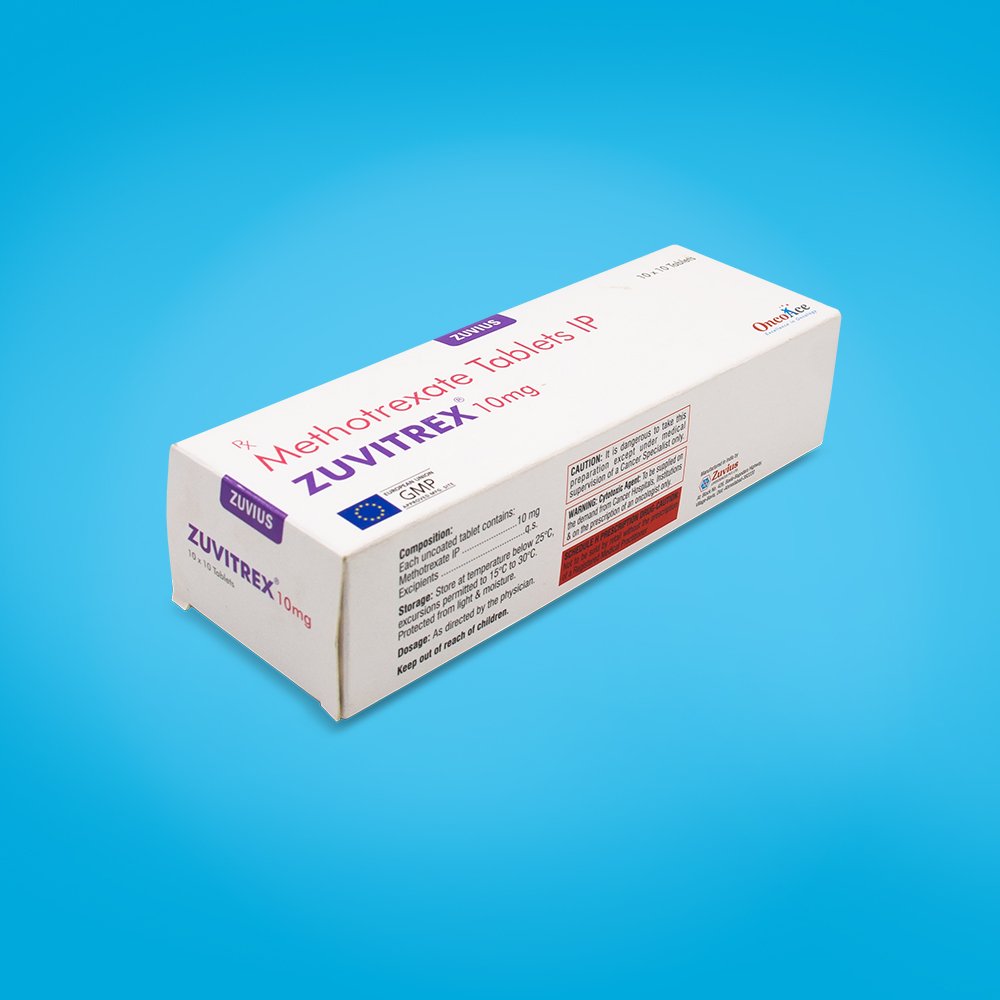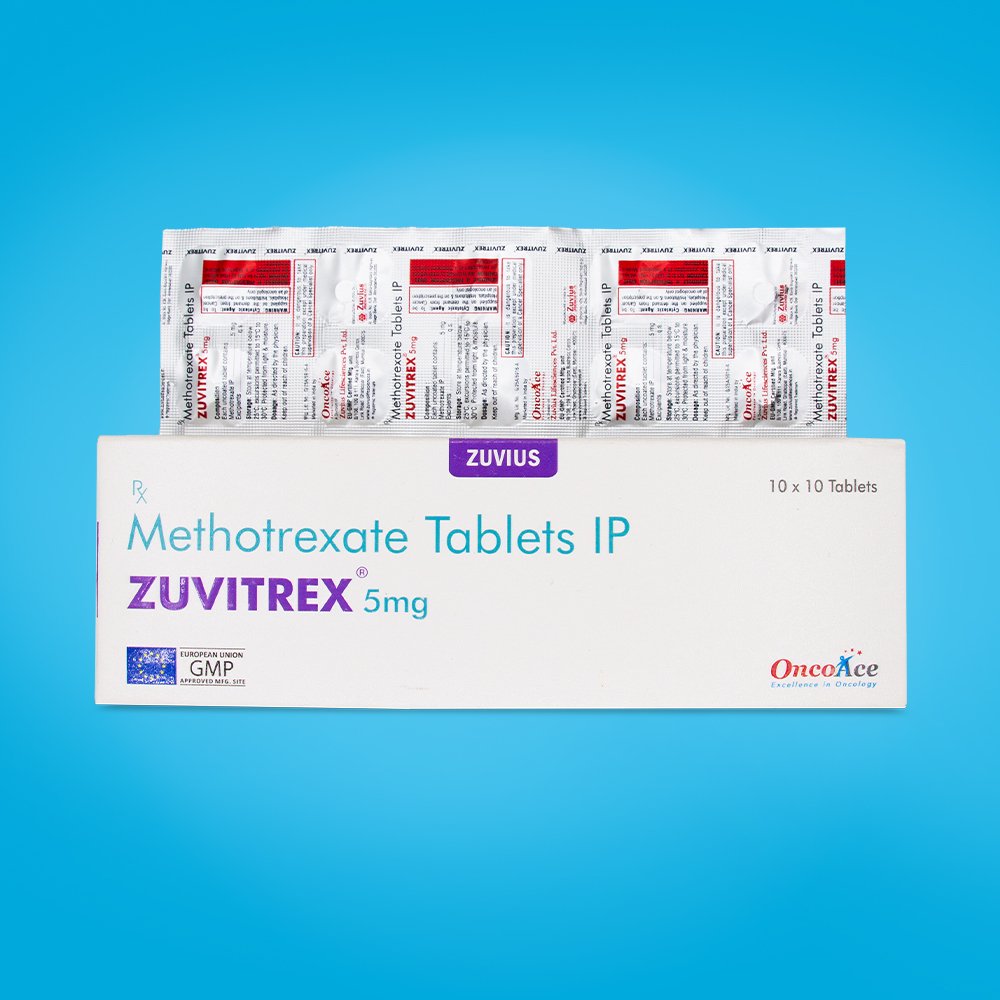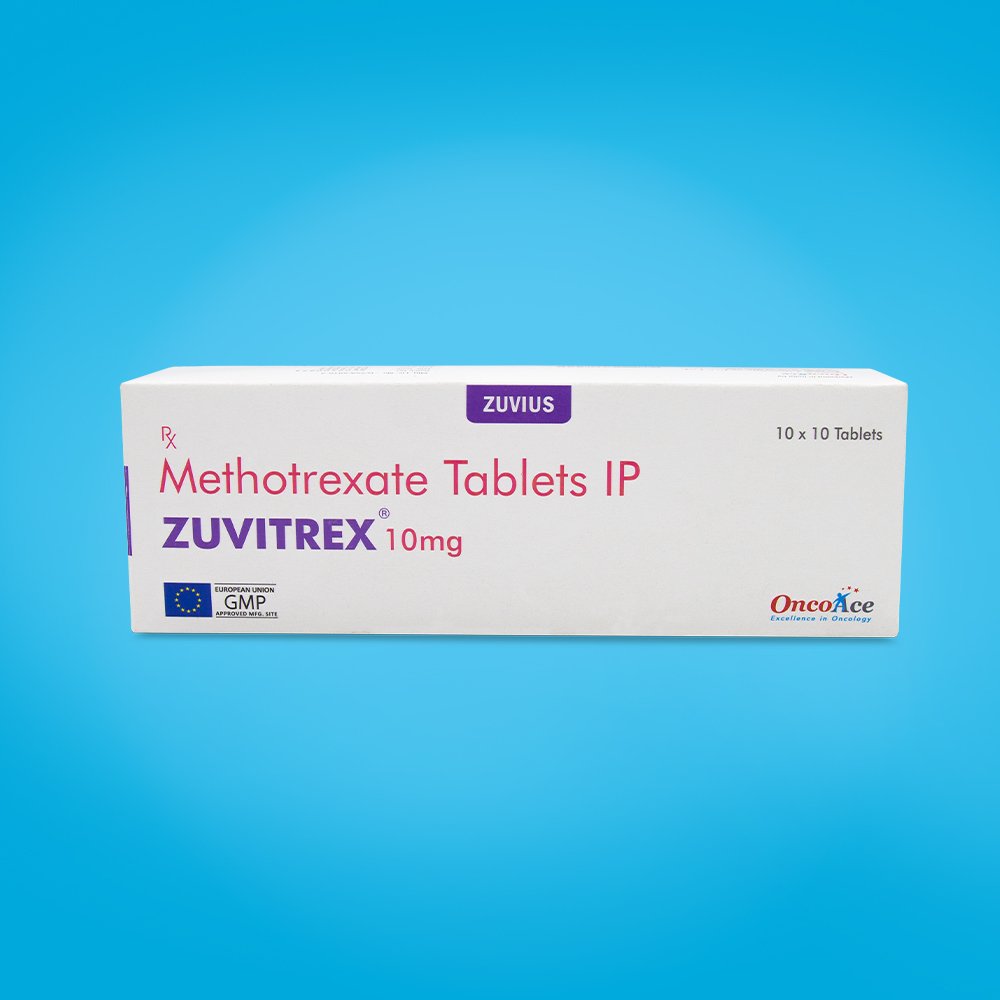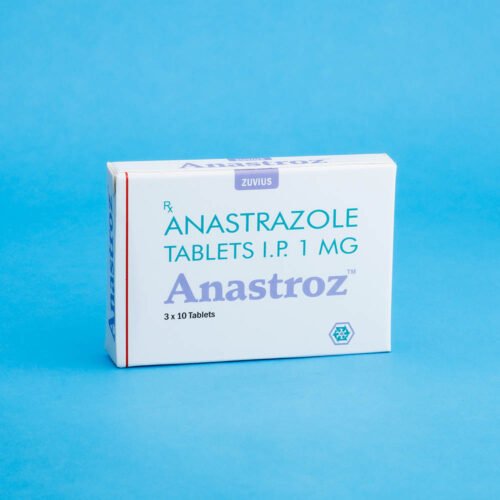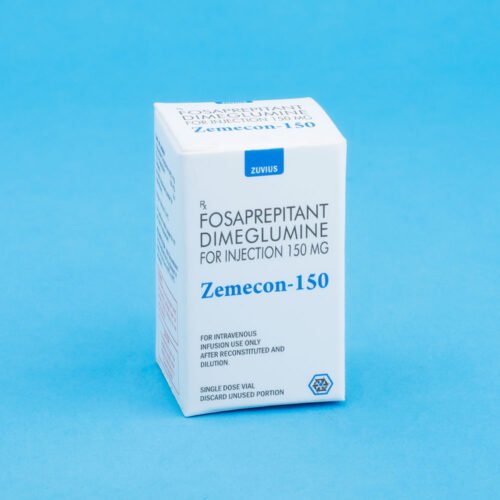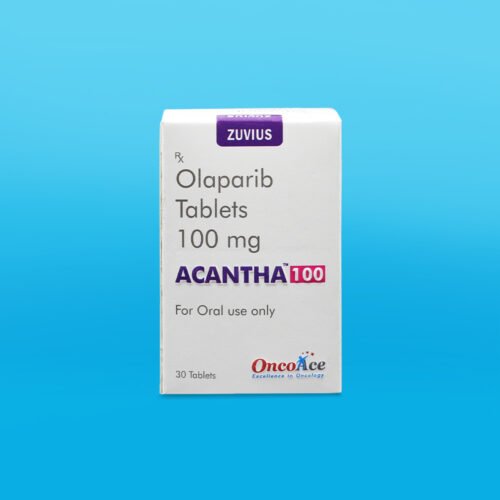Zuvitrex Tab- Methotrexate Tab
Methotrexate Tab
Strength: 2.5mg / 5mg/7.5 mg/10mg
Pack Size: 1 x 10
Drug Class: Other immunosuppressive Agents
Dosage and Administration:
The dose of methotrexate to be given, the frequency of dosing, the total dose and the combination with other cytostatic drugs and/or folinic acid are subject to frequent modification as our knowledge improves. Methotrexate should be only applied by Physician’s experience in the area.
Head and Neck Cancer :
Methotrexate at a dose of 40mg/m2 body surface area is given at weekly intervals, until progression. This dosage is used without folinic acid therapy.
Trophoblastic Tumours :
The treatment of trophoblastic tumors has to be strictly supervised by as assigned committee of exports, In patients with non-metastatic and low risk metastatic trophoblastic tumors a methotrexate dose of 15 to 30 mg daily is administered orally or intramuscularly for 5 days. A repeat course may be given after a period of one or more weeks. Three to five courses are usually employed. Patients with high risk trophoblastic tumours are often treated with a combination therapy, including 300 mg methotrexate/m2 body surface. followed by folinic acid therapy the therapy has to be evaluated on the basis of hCG (Human Chornic gonadotropin) plasma concentrations.
Leukemia :
Methotrexate is used as part of the maintenance therapy, in acute lymphoblastic leukemia at a dose of 15-30 mg/m2 orally, intramuscularly or intravenously once a week.
Psoriasis :
The treatment of psoriasis in women should start immediately following a menstrual period. Once week prior initiation of methotrexate therapy a test dose of 5-10 mg is given parenterally to detect idiosyncratic reactions of the patients. In adults weekly dosage schedule of 10-25 mg orally intramuscularly or intravenously is used. In most patients an improvement occurs usually within 4 week and an optimal results is reached in 2-3 months. Discontinuation of the methotrexate treatment gives relapse symptoms within 2 weeks to 6 months. After optional clinical result has been reached the dose should be reduced to the lowest possible with the longest intermediate time span possible. Conventional topical therapy should be restarted as soon as possible.
Rheumatoid Arthritis :
A single test dose of methotrexate may be given prior to initiation of therapy to detect possible sensitivity to adverse effect to the drugs. A weekly regimen is used. The recommended starting dosage schedule, is either a) single oral dosage of 7.5 mg once weekly or b) an oral dose of 2.5 mg at 12 hours intervals for three dosages given as a course once weekly. Althrough an upward gradual modification in either the single or divided dosage schedule may be done for optimisation of response, the total dosage usually should not exceed beyond 20 mg per week so as to avoid severe toxicity particularly bone marrow suppression associated with. After the optimum response is achieved the dose in each schedule should be preferably reduced to the lowest possible effective dose. The response, which is apparent by between 3-6 weeks may continue for three months or more. The optimal duration of therapy is not known. However limited response for at least 2 years with continued therapy. On discontinuation of therapy arthritis usually worsens within a span of 3-6 weeks.
or Intrathecal Use :
LEUKEMIA MENINGENEAL
IMPORTANT NOTE : Only preservative free methotrexate dilute with preservative free 0.9% Sodium Chloride Injection, USP or other suitable medium to a concentration of 1 mg / ml should be used for intrathecal administration.
Following intrathecal dosing regiments based on patient age
| Age (Years) | Dose (mg) |
| Less than 1 | 6 |
| 3 | 8 |
| 4 | 10 |
| 4 or older | 12 |
the treatment of meningeal leukemia, intrathecal (IT) methotrexate may be administered at intervals of 2 to 5 days. Caution should be exercised as IT methotrexate administered at intervals of less than once week may increase subacute toxicity. IT methotrexate should be given until the cell count of the CSF returns to normal, and then one additional dose. IT methotrexate adds significantly to the systemic methotrexate drug level. therefore, concurrent systemic antileukemic therapy should be appropriately adjusted.
DOSE MODIFICATIONS :
When the leukocyte count or thrombocyte count is decreased on the first day of treatment the dose of methotrexate, in case of a standard therapy with 40mg/m2 body surface, should be adapted according to the following scheme, the lowest value determines the reduction. %of Normal doseeucocuytes count / mm3hrombocyte
| Count/mm3 | ||
| 100 | >3500 | >12500 |
| 50 | 2500-3500 | 75000-25000 |
| 0 | <2500 | <75000 |
If the number of leukocytes is 2500-35000/mm3 and or the number of thrombocytes is 75000-125000 it is preferred to discontinue the treatment for once week. If the blood count has shown a recovery, the treatment can be continued. If the blood count is not recovered, a dose reductions can be applied .
Methotrexate should not be given to patients with a creatinine clearance less than 60ml./min. Therapy with high dose methotrexate should be postponed in case of in case of liver toxicity.
ROUTE OF ADMINISTRATION
For intramuscular, intravenous & intrathecal use.
Cold Storage: no
Methotrexate (formerly Amethopterin) is an antimetabolite used in the treatment of certain neoplastic diseases, severe psoriasis, and adult rheumatoid arthritis.
Chemically methotrexate is N-[4-[[(2,4-diamino-6-pteridinyl)methyl]methylamino] benzoyl]-L-glutamic acid. The structural formula is:
 |
Molecular weight: 454.45 C20H22N8O5
Methotrexate Tablets, USP for oral administration are available in a packaging system. Methotrexate Tablets, USP Dose Pack for therapy with a weekly dosing schedule of 5 mg, 7.5 mg, 10 mg, 12.5 mg, 15 mg, 17.5 mg and 20 mg. Methotrexate Tablets, USP contain an amount of methotrexate sodium equivalent to 2.5 mg of methotrexate and the following inactive ingredients: Lactose, Magnesium Stearate and Pregelatinized Starch.
Methotrexate is indicated in the treatment of choriocarcinoma, chorioadenomadestruens and molahydatidosa. In molahydatidosa primary therapy consists of the evacuation of the uterus. Methotrexate is used in prophylactic therapy. In the treatment of low-risk trophoblastic tumors, methotrexate is used as a single agent. It is indicated in Psoriasis and Rheumatoid arthritis.
n the treatment of high-risk trophoblastic tumors methotrexate is applied as a part of the multidrug regimen. Methotrexate is used in a normal dose or high dose as a single agent or as part of a multidrug regimen in the treatment of acute lymphoblastic leukemia. (CNS Leukemia and maintenance therapy), osteosarcoma Hodgkin’s lymphoma, Burkitt lymphoma, advanced cancer of the head and the neck, invasive tumors of the bladder, and in advanced stages of mycosis fungoides.
Usage-:
Methotrexate 2.5 mg Tablets are one of a group of medicines called antimetabolites which affect cell growth, including the growth of cancer cells. Methotrexate can be used to treat severe cases of psoriasis (a skin disease) and rheumatoid arthritis (a disease of the joints).Methotrexate 2.5 mg Tablets are one of a group of medicines called antimetabolites which affect cell growth, including the growth of cancer cells. Methotrexate can be used to treat severe cases of psoriasis (a skin disease) and rheumatoid arthritis (a disease of the joints).
Methotrexate inhibits dihydrofolic acid reductase. Dihydrofolates must be reduced to tetrahydrofolates by this enzyme before they can be utilized as carriers of one-carbon groups in the synthesis of purine nucleotides and thymidylate. Therefore, methotrexate interferes with DNA synthesis, repair, and cellular replication. Actively proliferating tissues such as malignant cells, bone marrow, fetal cells, buccal and intestinal mucosa, and cells of the urinary bladder are in general more sensitive to this effect of methotrexate. When cellular proliferation in malignant tissues is greater than in most normal tissues, methotrexate may impair malignant growth without irreversible damage to normal tissues.
The mechanism of action in rheumatoid arthritis is unknown; it may affect immune function. Two reports describe in vitro methotrexate inhibition of DNA precursor uptake by stimulated mononuclear cells, and another describes in animal polyarthritis partial correction by methotrexate of spleen cell hyporesponsiveness and suppressed IL 2 production. Other laboratories, however, have been unable to demonstrate similar effects. Clarification of methotrexate’s effect on immune activity and its relation to rheumatoid immunopathogenesis await further studies.
Methotrexate may increase the risk of problems with your liver or lungs, especially if you take a high dose. However, your doctor will monitor you very closely while you’re taking methotrexate. Any concerns or problems will be found during routine check-ups.
During methotrexatetherapy and until at least three months after treatment with methothotrexate contraceptive precautions should be taken by female as well as male patients.
While in general a low dose of methogerxate is applied in the treatment of psoriasis, as compared to the doses used in antineoplastic therapy, intoxication and death may occur. Patients should be fully informed on the risks of methotrexate therapy and should be instructed to report any manifestation of toxicity immediately.
The simultaneous use of methotrexate and other potentially hepatotoxic drugs or alcohol should be avoided.
Non-steroidal anti inflammatory drugs should not be administrated prior to or concomitantly with the high doses of methotrexate.
NSAIDs with high dose methotrexate therapy has been reported to elevate and prolong seru methotrexate levels, resulting in deaths from severe hematologic and gastrointestinal toxicity.
Oral antibiotics such as tetracycline, chloramphenicol and non absorbable broad spectrum antibiotics may increase intestinal absorption of methotrexate or interfere with the enterohepatic circulation by inhibiting bowel flora and suppressing metabolism of the drug by bacteria.










